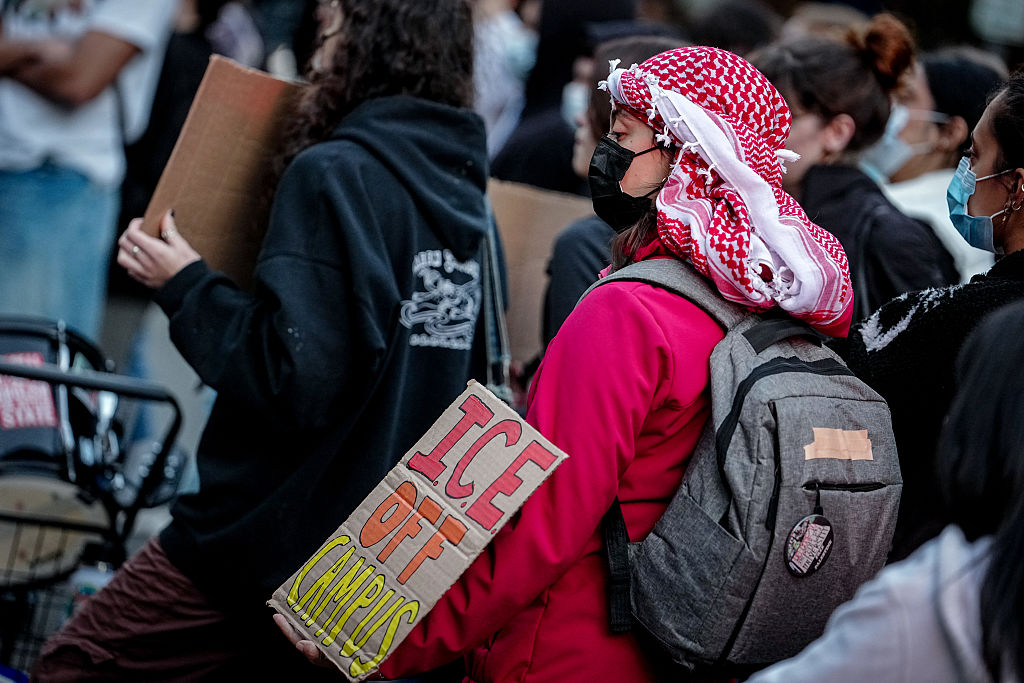Student Fears Over ICE Dominate Washington Education Meeting
‘You See ICE And You Panic.’ Student Fears Dominate Washington, D.C. Education Meeting As Officials Grapple With How to Rebuild Trust

What began as a routine discussion over how to spend a $30,000 student engagement budget quickly turned into a sobering look at fear, mistrust, and the limits of safety in Washington, D.C., schools.
At a recent meeting of the D.C. State Board of Education’s Committee on Student Experience and Engagement, the conversation veered sharply when students described feeling anxious about the presence of Immigration and Customs Enforcement (ICE) near school grounds.
Students told the board that seeing ICE agents near their schools makes them panic, even when they’re not the target. They described the presence of law enforcement as a constant source of anxiety. One student representative said that “a majority of the emojis students created expressed negative emotions. Students feel upset, concerned, or unsafe when ICE is around our schools.”
The comment struck a nerve. Committee chair Eric Goulet said the reaction was “not surprising,” warning that the presence of masked federal agents “erodes trust” between students and institutions. He cited reports of ICE detaining parents near Bancroft Elementary as particularly alarming.
Those fears aren’t unfounded. In March 2025, federal agents attempted to detain a health-care worker at H.D. Cooke Elementary School while students were arriving. The agents left only after administrators demanded a warrant. Earlier this year, parents and daycare staff in Northwest D.C. reported unmarked SUVs and plain-clothes officers outside bilingual childcare centers, sparking panic among immigrant families.
While D.C. has recently shown modest progress on attendance — its in-seat rate climbed to 87.4 percent last school year, and chronic absenteeism dropped to 36.9 percent — more than one in four students across the district still miss significant class time.
Nationally, studies show that immigration enforcement can drive attendance even lower. In districts hit by ICE raids, daily absences spiked by about 22 percent, with the sharpest increases among elementary-age students. Research from the Kaiser Family Foundation and the Learning Policy Institute confirms that heightened immigration enforcement correlates with chronic absenteeism, school withdrawals, and declines in academic performance. In other words, the panic students describe in D.C. isn’t isolated; it’s part of a measurable, nationwide chilling effect that turns fear into lost learning.
Some neighborhoods have even organized “walking school buses,” community escorts to help children travel safely to class after witnessing federal agents detain a parent in front of students. Educators say the heightened enforcement has already begun affecting attendance and the sense of security inside classrooms, according to WTOP News.
“The way to make students feel safer is to build trust,” Goulet said. “Actions like these do the opposite.”
Across the country, similar stories are unfolding in immigrant communities where schools are meant to be sanctuaries but often feel like extensions of law enforcement. In DC, where foreign-born residents make up nearly 14 percent of the population, students say the presence of ICE near schools fuels anxiety. Studies suggest that enforcement near schools can reduce attendance, especially among Latino students.
The ICE discussion overshadowed what was supposed to be a planning session about student engagement and safety initiatives.
The committee, working with a $30,000 budget, had been debating how to increase student participation in civic events, from listening sessions to a possible citywide student summit in March. Only three students had shown up to the previous town hall, despite 18 signing up, a turnout that underscored how mistrust and fatigue are already eroding civic involvement.
The attendance failure is evidence of the deeper emotional disengagement created by fear and disillusionment. It’s not just that students are afraid of ICE; it’s that the system built to hear them is operating on a shoestring and struggling to get them in the room.
Student Representative Kayla Chamberlin suggested offering community service hours as an incentive to draw more young people in. Others proposed smaller ward-based meetings, partnerships with youth groups, and translation services for families who don’t speak English.
“We’d hit the whole city,” said Ward 8 Representative Lajoy Johnson, arguing for events in every ward.
But beneath the logistics and policy talk was a more existential question: how do schools protect students from fear when the threat isn’t inside the classroom but waiting just beyond its doors?
The conversation expanded to youth curfews and law enforcement visibility—issues that carry similar undertones of mistrust. “We don’t want young people encountering the criminal justice system just for returning from a school event,” Goulet said.
By the meeting’s end, members had pledged to translate student feedback into tangible action to ensure that safety planning addresses not just physical threats but emotional ones. “It’s about making sure what students say doesn’t just get heard and it gets acted on,” said Rep. Dinkins.
For D.C. students, that action can’t come soon enough. The challenge now facing the city, and districts nationwide, is proving that safety and belonging can’t be legislated into existence; they have to be built.
Zoe Cummings is a senior honors journalism major, Spanish minor at Howard University, covering HBCU news, politics, and culture. You can follow her on Instagram @zoesxphia.
Grant Roundtree is a senior journalism major, political science minor at Howard University. He is interested in stories about culture, sports, politics, and issues affecting local communities. He can be reached on Instagram at @grantroundtree.
SEE ALSO:
Ethiopian Immigrants Live With Fear, Anxiety In Washington
Howard Students Hustle To Stay Enrolled After Federal Aid Cap
‘You See ICE And You Panic.’ Student Fears Dominate Washington, D.C. Education Meeting As Officials Grapple With How to Rebuild Trust was originally published on newsone.com











